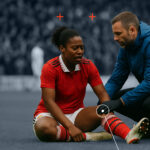Introduction
NCAA’s basketball championship was first introduced for men in 1937 and in 1982 for women.The game has changed considerably over the years. Although it is technically a non-contact sport, basketball is a fast and aggressive sport that has been shown to have high frequency of injury (Meeuwisse et al., 2003). The participation rates for both male and females competing in NCAA basketball has increased in recent years with 16,028 players taking part in the men’s game in 2003/2004 season and 14,596 participants in the female game (NCAA report 2006). The injury rate for males over a 16 year period from 1988-2004 has stayed the same (Dick et al., 2007); a similar trend in injury rate was found in the women’s game over the same period of time (Agel et al., 2007).
Rate of injury
In both male and female NCAA basketball there is a high rate of injury during the preseason phase. 6.75 injuries per 1000 athletic exposures (A-Es) in females and 7.5 injuries per 1000 A-Es in males. The high rate of preseason injury could be attributed to a multitude of factors such as deconditioning which occurs during the offseason, the increased intensity during preseason as players try to earn roster spots and early season fatigue (Agel et al., 2007). The high rate of injury during the preseason highlights the need for careful planning of player offseason conditioning strategies as well as the clear need for daily monitoring during this intense period. In both codes of the sport games were found to have an injury incidence twice that of practices, this is most likely caused by the player-player contact, the increased intensity and the uncontrolled game scenarios.
The standard of NCAA division has an impact on injury incidence. Injuries are more frequent in Division I athlete than in Division II and there is a higher injury rate in Division II than in Division III. Interestingly Division I athletes on average play more games (DI 28/27, DII 27/26, DIII 24/24 males/females), have a higher number of practices (DI 94/89, DII 82/79, DIII 73/65 males/females) whilst having the lowest average number of athletes per practice (DI 13/12, DII 14/12, DIII 16/13 males/females) this might explain the higher injury incidence as there are fewer players performing more regularly which increases the chance of injury. Again this underlines the need for careful planning and periodisation of S&C programs as well as the clear need for the monitoring of players on a per athlete basis.
Most injured areas
In both male and female athletes the most commonly injured body parts are ankle ligament sprains (24.6%), knee internal derangements (15.9%) and concussions (6.5%) (Agel et al., 2007 Dick et al., 2007). In the male game over half of game injuries come from player contact (52.3%) and 24.3% from other contact. In practice over 60% of all injuries occur due to contact (Dick et al., 2007). In the women’s game nearly 70% of all game related injury mechanisms are contact in nature, interestingly 47% of total practice injuries are noncontact in nature (Agler et al., 2007). There is a difference in the injury mechanisms during practice and during games. In games fewer athletes participate but they are participating at a higher level of intensity than in practice. High intensity activities are associated with fatigue and when it is combined with a competitive environment that is unpredictable in nature this may predispose the athlete to more acute injuries than in practice.
Ankle sprains
The ankle is the most susceptible bodypart to injury in basketball. In fact ankle sprains account for up to 24.6% of all injuries in both male and female NCAA basketball. This is unsurprising as basketball is characterized by sprinting, rapid changes of direction, repeat jumps and landings. Hosea et al., (2000) reported that there was a 25% greater risk of women sustaining an ankle injury than their male counterparts in collegiate basketball. Protective equipment such as high top shoes and in shoe orthotics along with certain preventative strategies like taping and bracing the ankle have been cited as a means to reduce ankle ligament injuries (Thacker et al., 1999 and Garrick et al., 1973). McKay et al., (2001) reported that 45% of ankle injuries were sustained during landing and 30% occurred during a cutting or twisting maneuver. Ankle sprain recurrence rate is particularly high at 70% in basketball so avoidance of this injury is of paramount importance for young aspiring basketball players. Greater importance on jump landing and agility exercises in their conditioning programs could help to reduce the injury incidence.
Stress Fractures
Stress fracture injury incidence trend has been increasing in recent years. Hame et al., (2004) noted that women were more susceptible to stress fractures in the foot whereas men were more susceptible to stress fractures at the ankle. A study by Ardnet et al., (1995) found that in NCAA athletes nearly half of all stress injuries were associated with a change in training regime, once again this highlights the importance of both careful planning of S&C programmes as well as the need for athlete monitoring throughout a season.
Anterior cruciate ligament injuries
Although ankle injuries are the most common injury in NCAA basketball, injury of the anterior cruciate ligament (ACL) is one of the most severe, career debilitating injuries and is amongst the most frequent knee injury occurring in elite high school and collegiate athletes (Kamath et al. 2014). Noncontact ACL injuries account for 70% to 84% of all ACL tears in both female and male athletes and have been shown to occur after initial contact in landing or cutting maneuvers with the knee at full extension. Annually ACL injuries account for 2.6% of all injuries in the NCAA (Kamath et al. 2014). ACL injuries accounted for 8% of all game injuries in female NCAA basketball. Such an injury can have a traumatic effect on athletes and can result in potential loss of entire seasons of sports participation and a possible reduction scholarship funding, significantly lowered academic performance (Freedman et al. 1998). With such a big impact on the careers of elite young athletes, there is a clear need for the standardisation of ACL injury monitoring throughout the NCAA.
Concussions
Concussions account for 7% of total injuries in NCAA basketball in the female game and 3.6% in the male game (Agel et al., 2007 and Dick et al., 2007). Although basketball is considered a non contact sport, the increasing use of elbows during play heightens the risk of concussive injuries to athletes. As the size of players and speed of both the male and female game continue to increase, basketball may complete the evolution from a finesse sport to more of a high-risk contact sport. This may explain the increase in rates of concussion.
Conclusion
The current monitoring of NCAA basketball players is exclusively based on heart rate, GPS and number of games each athlete is participating in. While these factors are hugely importing in reducing injury risk, the monitoring of athletes biomechanical status provides more information and can allow for a reduction in injury risk for specific high risk injury areas. A study by Canavan et al., (2012) found that range of motion (ROM) should be assessed in a number of different areas for NCAA basketball players. Specifically they cited ankle dorsiflexion, left and right lower extremity ROM to identify bilateral differences and following from this there should be targeted interventions based on each individual athletes screening. The in-season screening and monitoring of athletes’ biomechanics is paramount in helping to reduce injury risk to the most at risk body parts and could help a team to optimise their performance during an intense period of competition like March madness.




